8-1 Early Cognitive Development
A – Early Cognitive Skills
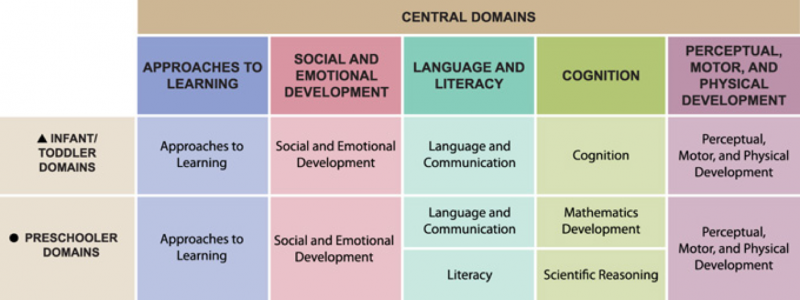
The infant and toddler Cognition domain of the Head Start Early Learning Outcomes Framework includes the development of early cognitive skills, such as:
- Using active exploration
- Understanding causal relationships
- Planning solutions to problems
For example, the developmental progression of the Exploration and Discovery subdomain shows children’s growth from using senses and actions to examine objects, to acting intentionally to achieve a goal, and finally to observing and experimenting with how things work.
The Cognition domain encompasses five subdomains. As mentioned, one is Exploration and Discovery. The other four are:
- Memory
- Reasoning and Problem-Solving
- Emergent Mathematical Thinking
- Imitation and Symbolic Representation and Play
Exploration and Discovery
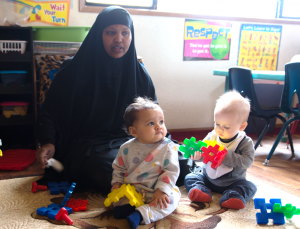
Let’s discuss one of the five Cognition subdomains, Exploration and Discovery. Exploration and discovery is at the heart of theory building and testing.
Children have an incredible amount to learn in the first few years of life. Children are natural scientists. They learn from observations, predictions, and exploration.
Children are constantly building theories about the world. A theory is a guess or possible explanation for something. It’s how children learn about everything, from relationships to language to scientific ideas like gravity.
Children can then test those theories by making observations or designing interventions to see what happens. For example, infants may have a theory that when they drop a toy they’re holding in their hands, it will fall to the ground. They may then experiment with dropping different objects to the ground and may even try doing so from different heights. When children encounter contradictions to their theories, they can update their theories. In this case, if they were to try to drop a helium balloon, they might reason that not all objects fall when dropped.
Skill Progression
As children develop their exploration and discovery skills, they move from exploring objects with their senses to testing theories about those objects’ causal relations in the world. They do this through active exploration of the world, which is a large part of what children are doing when they play.
Play for infants and toddlers involves a lot of sensory activity because their brains are fine-tuning many of the sensory regions. Toys that have interesting sensory features, such as bright colors or varied textures, offer opportunities for sensory play.
Infants are actively exploring the environment, at first sucking, then grabbing or dropping objects, and eventually intentionally testing objects’ properties, such as whether they float or sink or whether they are magnetic or not.
With object exploration, young children are also starting to learn about cause-and-effect relations.
Infants are constantly engaging in exploration and discovery, so much so that you may have missed when this is occurring. Let’s watch a quick video example of infant exploration in action.
Video: Milestones in Action (0:09)
This short video clip from the Centers for Disease Control and Prevention (CDC) shows a 1-year-old exploring an object. The video is 9 seconds long.
While watching the video, think about the following questions:
- What was the child exploring and what did they discover?
- Is this a behavior you’ve seen before?
- What important skills is this infant demonstrating?
- What could you do to encourage this kind of behavior in future interactions?
Watch Milestones in Action from CDC.gov.

Video Debrief
What did you observe about exploration and discovery? (click to toggle expand or collapse)
Consider the following possible answers:
- What was the child exploring and what did they discover? The child was exploring two plastic cups and discovered that banging them together made a noise.
- Is this a behavior you’ve seen before? Think about your personal experiences.
- Describe the important skills this infant is demonstrating. The child is exploring the characteristics of objects and causal relationships. The child is also building physical skills in bringing the objects together to touch one another.
- What could you do to encourage this kind of behavior in future interactions? To help build children’s theory of the world, which at this point could be, “When I bang things, they make a certain sound,” you can give infants objects with varying sensory experiences. These could be ones that make different sounds when banged together or ones that when banged together make no sound at all (soft toys).
Using Observations
Researchers have studied infant exploration and found that even young infants don’t play with objects at random. They direct their exploration based on the information they have observed.
For example, 1-year-old children learn physical rules through observation and experimentation. When they see something that violates typical physical rules, they are more likely to explore it.
In one study, researchers showed young children a simple scene: a toy car rolling on a surface. Some children saw a toy car that was pushed off the side of a table then hover in mid air—something a car clearly could not do. Others saw a toy car rolling down a ramp and going through a solid barrier—also impossible.
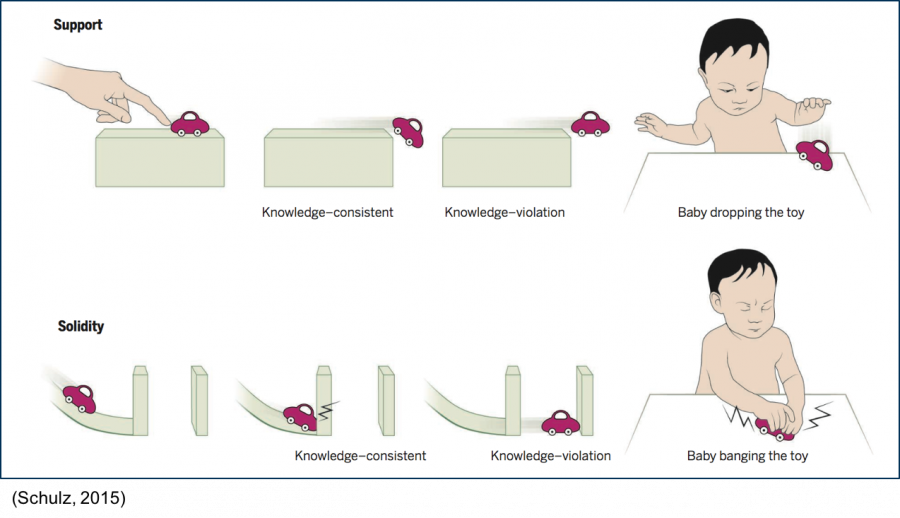
When these children had a chance to play with these mysterious cars, they tended to direct their exploration toward specific features. Those who saw the car hover in mid air tended to drop the car, whereas those who saw the car go through the barrier tended to bang it against the table.
B – Understanding Causal Relationships
Cause and Effect
Cause-and-Effect Blicket Detector

As children develop, their ability to recognize complicated cause-and-effect relationships improves. By the time children reach toddlerhood, they have a surprisingly sophisticated understanding of causes, or of things that make other things happen, such as buttons that make machines light up and play a sound.
One way researchers have tested this is through a contraption they call a blicket detector.
What is a Blicket?
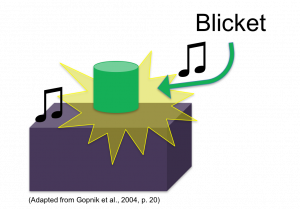
There are many variations of the blicket study. In almost all versions, the blicket detector is a small wooden or metal platform that lights up or plays music when a blicket is on top.
Blickets themselves can be anything researchers imagine. Usually they are blocks of different colors or shapes. The blickets do not have magic powers to activate the machine. The experimenter secretly pushes a button to make the machine turn on.
From a child’s perspective, it seems like certain objects really must have properties that make the toy light up or play music.
After seeing a variety of toys placed on the blicket detector and watching whether they activate the machine, children need to determine what is or is not a blicket.
 Interactive: Blicket Detector
Interactive: Blicket Detector
This is an interactive! Drag and drop the red and blue blocks on the black blicket detector to discover which block is the blicket.
 Activity Debrief
Activity Debrief
By observing which objects make the blicket detector work, children make sophisticated guesses about what is and isn’t a blicket. It turns out they do not even need to see that one specific toy makes the blicket detector go. They can use their observations to reason about it.
Which block is the Blicket?
Why it matters
Vroom Tip
Check out this Vroom tip to get more ideas about how to help build children’s cognitive development in the area of cause-and-effect relationships.
Does this tip make sense in the context of an early learning environment? If not, how might you adapt the activity to better fit that environment?
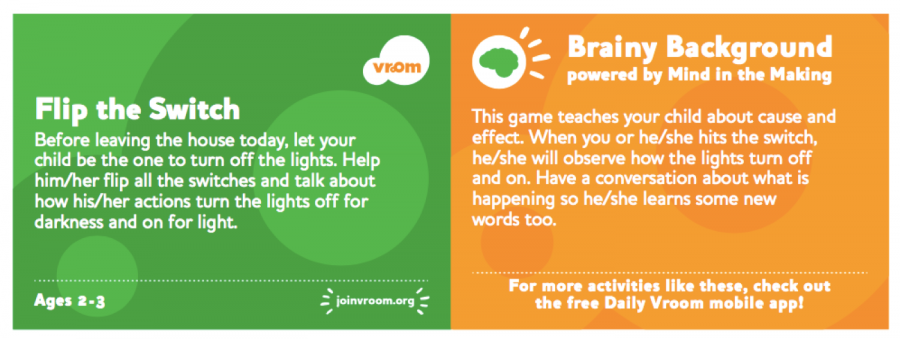
View text-only alternative of this Vroom card
Flip the Switch
Before leaving the house today, let your child be the one to turn off the lights. Help him/her flip all the switches and talk about how his/her actions turn the lights off for darkness and on for light.
Ages 2-3
Brainy Background powered by Mind in the Making
This game teaches your child about cause and effect. When you or he/she hits the switch, he/she will observe how the lights turn off and on. have a conversation about what is happening so he/hse learns some new word too.
C – Memory Development
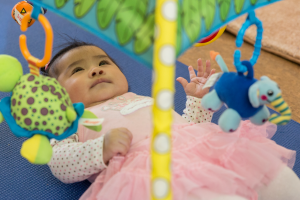
The development of memory is critical to many domains. Memory is at the heart of learning. If you can’t remember something, then you can’t learn and grow cognitively.
You may think that since you don’t remember anything from when you were a baby, that infants and toddlers have little or no memory capacity. However, researchers have shown that infants as young as 6 months can retain learned actions, such as kicking to get a mobile to move, for up to 2 weeks and sometimes longer, depending on the training.
Brain Structures
As children age, the brain structures supporting their memory development grow and mature. They become able to support longer and longer memory retention. Between the ages of 2 and 18 months, children go from not remembering learned information from the week before to remembering something learned more than 12 weeks prior. That’s 3 months, or one-sixth of their current lifespan. That would be like remembering something specific you learned up to a decade ago (depending on your age).
As children get older, their memory also gets better so that they are able to retain information for longer and longer periods of time.
 Interactive: Deferred Imitation
Interactive: Deferred Imitation
This is an interactive! Use the slider to explore the graph.
Have you ever noticed children repeating actions that you only did once in your program? Imitation is a powerful tool for learning in early childhood and one that educators have used for centuries to pass information to future generations.
In the early learning environment, an educator can use imitation to demonstrate new actions on an object, even with infants as young as 9 months old. Repeating those demonstrations more often for younger infants will help them retain that learning longer.
Skills with Memory Maturation
As children’s memory grows and matures, they will be able to adopt new skills, such as:
- Recognizing when objects and people are familiar versus new.
- Knowing that an object is still there, even when it is hidden. (This supports later symbolic learning.)
- Remembering daily routines.
Directing Attention
To recognize that something is new, you first must remember what you’ve already seen or experienced. Researchers have shown in a visual recognition task that children as young as 1 year old begin to retain memories of at least three to four previously viewed items.
This ability helps them to remember what they have and have not seen before and to notice changes in their environment. This, in turn, can help them direct their attention and their exploration to new objects or places. It also helps them to recognize familiar and unfamiliar people, which helps them track people and behaviors as part of their social development.
Object Permanence
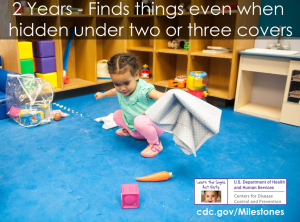
Memory is also key to children’s spatial learning and understanding the stability of people and objects. This ability is commonly referred to as object permanence: Even when you don’t see things, they are still there and have not just disappeared.
One of the easiest ways to test children’s object permanence is to hide something in front of them and observe their searching behaviors. When you hide a favorite toy in front of infants, they will turn around and appear completely uninterested, as if the object has just disappeared and doesn’t exist anymore. They won’t bother searching for it at all.
As children get older, they will begin to search for the object and get better and better at finding it. Before 4 to 8 months, infants abide by the out of sight, out of mind principle and generally won’t search for an object even if it is only partially hidden.
Between 4 and 8 months, most infants will start to look for an object if it is partially covered. Between 8 months and 1 year, most infants will begin to search for and retrieve a completely covered object.
Between 18 months and 2 years, most children have reached full object permanence and will search for a hidden object, even if the object is hidden under multiple covers.
Planning Actions
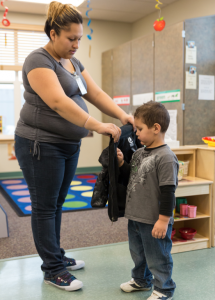
Another way that children’s developing memory helps their overall cognitive development is in their ability to plan future actions.
This is especially evident in how children learn to be able to remember the steps of daily routines, such as the process of getting to school or coming home. They are able to predict what is coming next and understand how they can prepare for it. This is one of the reasons that building stable routines into children’s daily schedules can help support their cognitive development. It allows them to practice their ability to remember and predict future events.
For example, children may prepare to leave the house by putting on socks, then shoes, then a coat, or get ready to go to bed by first brushing teeth, then reading a book, then turning off the light. As children get older, they can use their memory of the routine to take an active role in those daily activities.
Narrating the steps in daily routines, both before they occur and while they occur, as well as using visual aids with schedules, will help reinforce those routines. It can be especially helpful for children who are dual language learners to keep track of routines as they occur.
Past and Future – Encouraging Learning
Consider this example scenario to courage learning in an ELOF subdomain:
- Subdomain: Memory
- Past: You could describe a child needing help with the morning snack routine of washing hands, finding a seat, putting their plate in the dish bin, and then washing hands again. After a couple months, the child remembered all the steps of the routine on their own.
- Future: You could then consider how to help children learn the routine faster by:
- Using visual aids to list the steps in the snack routine in pictures.
- Reviewing the steps with the children each morning before snack time.
- Announcing transitions during each step of the routine while referring to the visual representation.

Reflection Point
Pick one of two Cognition subdomains from the Head Start Early Learning Outcomes Framework:
- Exploration and Discovery
- Memory
Recall an experience with a child that demonstrates learning in that subdomain. Envision an experience in which you could encourage children’s learning in that subdomain.
D – Reasoning and Problem-Solving
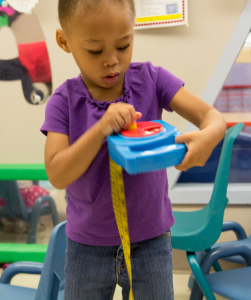
Reasoning and problem solving in infants and even toddlers may seem even more far-fetched than memory or discovery, but in fact, from birth to age 3, children are engaging in many reasoning and problem-solving activities.
For example, look at the photo here. The child appears to be trying to figure out how to wind up the tape measure. This activity includes a number of reasoning and problem-solving behaviors.
Increasing Strategies
Children learn to try a variety of problem-solving strategies and to begin planning solutions. For example, the child in the photo above might:
- Try to turn the knob different directions.
- Ask a nearby adult for help.
- Use a trial-and-error approach, such as trying to push the tape back in the slot or to pull it out further.
These are different problem-solving strategies that children may develop between birth and age 3, as described in the goals for Reasoning and Problem-Solving in the Head Start Early Learning Outcomes Framework. As children get older and the goals get more complex, they will build more problem-solving strategies to deal with new and more complicated problems that might arise.
Future Planning
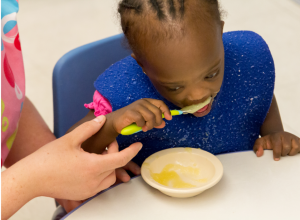
Infants as young as 10 months even show signs of future planning. They do this in their motor movements.
One study found that if adults asked 10-month-olds to pick up a toy and throw it, the infants would approach the toy with their hand differently than if they were asked to pick up the same toy and fit it into a tube. This shows that by the time the infants were reaching for the toy, they were already planning their next action with that toy.
However, young infants are limited in their ability to plan future actions. As children get older, you can see their future planning and problem-solving change.
A second study took an interesting approach. Researchers presented infants with a spoon with which to eat, but they handed it to them from the wrong side. For example, if you are right-handed, it’s easier to grab a spoon if someone hands it to you with the handle on your right-hand side. If someone hands it to you with the handle on the left-hand side, you have to first grab it with your left hand and then move the spoon around to orient it properly for gripping with your right hand.
This second study presented 9-, 14-, and 19-month-olds with the spoon handle on the wrong side and found some striking differences in how infants planned to grip the spoon.
 Interactive: Corrections after Gripping Spoon
Interactive: Corrections after Gripping Spoon
This is an interactive! Use the slider to explore the graph.
Vroom Tip
Check out this Vroom tip to get more ideas about how to help build children’s cognitive development in the area of reasoning and problem-solving skills.
Does this tip make sense in the context of an early learning environment? If not, how might you adapt the activity to better fit that environment?
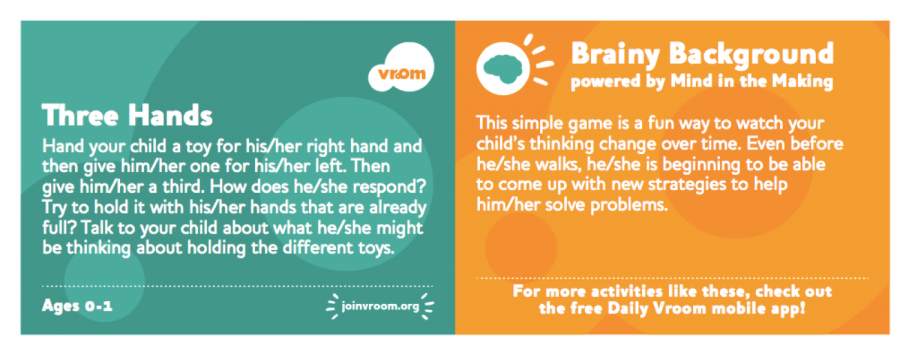
View text-only alternative of this Vroom card
Three Hands
Hand your child a toy for his/her right hand and then give him/her one for his/her left. Then give him/her a third. How does he/she respond? Try to hold it with his her hands that are already full? Talk to your child about what he/she might be thinking about holding the different toys.
Ages 0-1
Brainy Background powered by Mind in the Making
This simple game is a fun way to watch your child’s thinking change over time. Even before he/she walks, he/she is beginning to be able to come up with new strategies to help him/her solve problems.
E – Emergent Mathematical Thinking
Development of Mathematical Thinking
The fourth Cognition subdomain is Emergent Mathematical Thinking. Math is important for any number of cognitive tasks, and the development of mathematical thinking begins much earlier than had been previously thought.
As early as 5 months of age, infants can represent very small numbers (1 and 2) and appear to understand at least the basic concept of increasing numbers of objects.
 Interactive: Expectations about Numbers
Interactive: Expectations about Numbers
This is an interactive! Use the slider to explore the infographic.
This suggests that infants as young as 5 months have expectations about stability and number count for at least up to two objects. However, infants are limited in their number abilities. They did not notice anything surprising when they watched the same process with a 2 + 2 model, where two puppets were initially on stage then researchers placed two more behind the screen.
Developing Cognitive Skills
Mathematical thinking is not just about understanding numbers. The Emergent Mathematical Thinking subdomain also includes a number of other developing cognitive skills, such as:
- Understanding comparison of quantity, such as more than or less than.
- Solving puzzles, meaning a basic understanding of shape and size and of relationships between multiple shapes.
- Sorting, or understanding that objects (and even people) have attributes that both differ and overlap; noticing those similarities and differences; and using them to create sets of objects.
Understanding Small Numbers
Another study explored infants’ mathematical thinking about small numbers using the math concept of quantity comparison, or judging more-than or less-than relationships.

Infants between 10 and 12 months watched someone place crackers in two different bowls. The number of crackers in each bowl differed. One always had more crackers than the other. Infants then could crawl to the bowl of crackers of their choice.
The study found that both 10- and 12-month-olds were good at choosing the bowl with the larger number of crackers when the amounts were relatively small, such as one versus two or two versus three.
When the numbers increased, for example three versus four or two versus four, both 10- and 12-month-olds didn’t seem to notice any differences in quantity.
Larger Sets
Although recognizing the number of a larger set objects, such as the difference between three and four crackers or two and four crackers, is challenging for infants, when the numbers get large enough, infants actually start to perform well again.

For example, 6-month-old infants first saw a number of different images of four dots until they got bored of seeing four dots. This is habituation, when an infant no longer reacts or is interested in something after multiple exposures to it.
At this point, researchers showed infants two images, one with four dots and one with eight dots. If infants were able to tell the difference in the number of dots, they should be interested in the eight-dot image and not the four-dot image. If they couldn’t tell the difference, they should treat the two images the same.
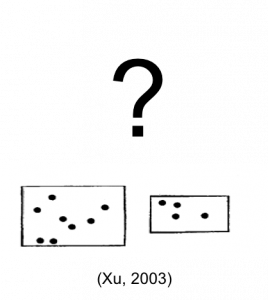
Six-month-olds reliably looked to the new, eight-dot image, which means that they could tell the difference between those with eight dots and those with the familiar four dots.
They could even do this with eight and 16-dot images. However, they did not notice a difference when the number of dots between the images was too close together, such as when the researchers tried images with eight and 12 dots. Infants could tell the difference between large sets of objects as long as the two quantities were different enough from each other.
As you can see, while infants have limitations, they are already starting to perceive and react to differences in number and quantity. Conversing with infants and toddlers about quantity and number can enrich their cognitive development in this area. Even if an infant doesn’t know how to say numbers yet, or even talk at all, they are still paying attention to number and quantity information.
Video: Everyday Fun with Measurement (3:00)
The Zero To Three video Everyday Fun with Measurement: Let’s Talk About Math shows infants engaging in emergent mathematical thinking. The video shows children from birth to 5 years and focuses on older children in that age range during the last minute.
While you watch the video, think about these questions:
- What beginning measurement skills are young children developing?
- How are adults fostering their learning?
Watch Everyday Fun with Measurement from ZEROTOTHREE on Vimeo.

Video Debrief
What did you notice that children were learning about? (click to toggle expand or collapse)
Possible Answer
You may respond that young children are learning about:
- Distance
- Comparisons, such as size and length
- Concepts like full and empty
- Non-standard and standard measuring tools
You may say that adults can help foster children’s learning by:
- Using simple measurement words like big, small, fast, slow
- Playing games like Fill and Dump
- Encouraging sorting by size
- Helping cook and do household tasks
Demonstrating Math Skills
Other ways that children demonstrate their developing mathematical thinking between birth and age 3 is through their play with objects.
As they get older, they begin to notice more object attributes or features, usually starting with obvious ones like shape and color, and eventually develop a sense for nonobvious attributes, such as sound and texture or size and weight. Once children begin to notice these attributes, they also start to practice sorting objects based on them, creating sets of common objects and differing ones.
Similarly, children’s ability to play with and solve puzzles also increases with their increased awareness of objects’ attributes. Solving a puzzle requires noticing the respective shapes of two objects and considering whether they would fit together.
F – Imitation and Symbolic Representation and Play
Practicing Real-World Events and Actions
Through imitation, symbolic representation, and play, children learn about how the world works. They can practice real-world events and actions and use their knowledge to experiment directly on the world.
Copying What Adults Do
From birth, infants can and will try to copy the acts that they see adults performing. Children can imitate adults in many ways during their first year of life. Even newborns show some rudimentary form of imitation, imitating those actions that they are capable of re-enacting, such as sticking out their tongue. Children can also use vocal imitation to learn new words and sounds. As they get older, they can copy adult body movements and actions on objects.
Imitating Effective Actions
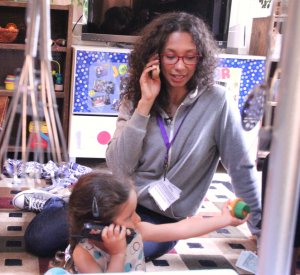
Children don’t just imitate every action they notice. One study found that children are more likely to imitate actions that are always effective than ones that work only some of the time.
For example, 18-month-olds would be more likely to imitate an adult pushing a button to turn on a light if that action always results in the light turning on.
In the study, 18-month-olds watched an adult perform a task that either always worked or only worked some of the time.
- When it always worked, 75 percent of the children imitated the action.
- When it worked only sometimes, 31 percent imitated the action.
Symbolic Representation
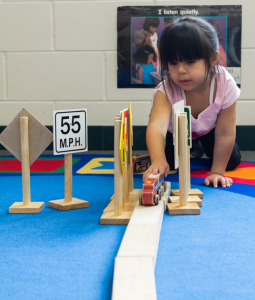
Pretending that objects are something else is one way that children begin to develop their symbolic representation. Between ages 1 and 2, children start to pretend with objects. This is characteristic of symbolic representation. They use one object to stand in for or symbolically represent another object.
For example, the child in this picture is pretending to drive a train on blocks that are standing in for train tracks.
This kind of symbolic representation is important for later development of symbolic reasoning, which is important for many other developing skills, such as language and math.
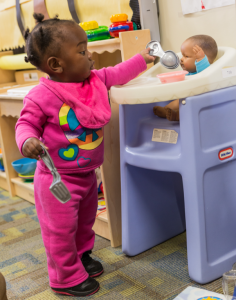
Re-Enacting Daily Activities
Children during this time in development also will begin to use play to re-enact daily activities, such as feeding their doll or teddy bear.
Some children might even use this kind of play to act out stressful events. This helps them process those events and work through them in a safe environment. It also supports their social-emotional development and problem-solving skills.
 References
References
Angier, N. (2012, April 30). Profiles in science: Insights from the youngest minds. The New York Times. [News Article]
Claxton, L., Keen, R., & McCarty, M. (2003). Evidence of motor planning in infant reaching behavior. Psychological Science, 14, 354-356.
Feigenson, L., Carey, S., & Hauser, M. (2002). The representations underlying infants’ choice of more: Object files versus analog magnitudes. Psychological Science, 13, 150-156.
Gopnik, A., Glymour, C., Sobel, D., Schulz, L., Kushnir, T., & Danks, D. (2004). A theory of causal learning in children: Causal maps and Bayes nets. Psychological Review, 111, 3-32.
Hartshorn, K., Rovee-Collier, C., Gerhardstein, P., Bhatt, R. S., Klein, P. J., Aaron, F., . . . Wurtzel, N. (1998). Developmental changes in the specificity of memory over the first year of life. Developmental Psychobiology, 33, 61-78.
Klein, P. J. & Meltzoff, A. N. (1999). Long-term memory, forgetting, and deferred imitation in 12-month-old infants. Developmental Science, 2,102–113.
McCarty, M., Clifton, R., & Collard, R. (1999). Problem solving in infancy: The emergence of an action plan. Developmental Psychology, 35, 1091-1101.
Meltzoff, A.N., & Moore, K. (1977) Imitation of facial and manual gestures by human neonates. Science, 198, 75-78.
Meltzoff, A.N. (1995). What infant memory tells us about infantile amnesia: Long-term recall and deferred imitation. Journal of Experimental Child Psychology, 59, 497-515.
Rose, S., Feldman, J., & Jankowski, J. (2001). Visual short-term memory in the first year of life: Capacity and recency effects. Developmental Psychology, 37, 539-549.
Rovee-Collier, C. & Sullivan, M. (1980). Organization of infant memory. Journal of Experimental Child Psychology Human Learning, 6, 798-807.
Schulz, L., Hooppell, C., & Jenkins, A. (2007). Judicious imitation: Children differentially imitate deterministically and probabilistically effective actions. Child Development, 79, 395-410.
Schulz, L. (2015, April 3). Infants explore the unexpected. Science, 348(6230), 42-43.
Stahl, A., & Feigenson, L. (2015, April 3). Observing the unexpected enhances infants’ learning and exploration. Science, 348(6230), 91-94.
U.S. Department of Health and Human Services, Centers for Disease Control and Prevention. (n.d.). Important milestones: Your child by two years. [Website]
U.S. Department of Health and Human Services, Administration for Children and Families, Office of Head Start. (n.d.). Head Start Early Learning Outcomes Framework: Ages birth to five. [PDF]
U.S. Department of Health and Human Services, Centers for Disease Control and Prevention. (n.d.). 1 year milestone: Explores things in different ways, like shaking, banking, throwing. [Video]
Vroom. (n.d). Vroom tips. [PDF]
Wynn, K. (1992). Addition and subtraction by human infants. Nature, 358, 749-750.
Xu, F. (2003). Numerosity discrimination in infants: Evidence for two systems of representations. Cognition, 89, B15-B25. [Online Article]
EarlyEdU Alliance (Publisher). (2018). 8-1 Early cognitive development. In Child Development: Brain Building Course Book. University of Washington. [UW Pressbooks]

